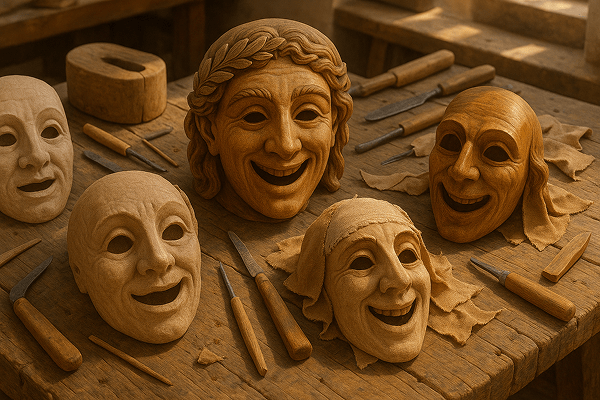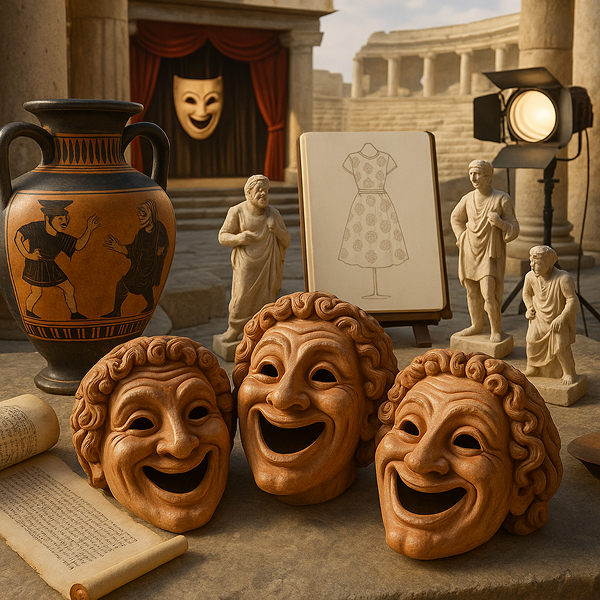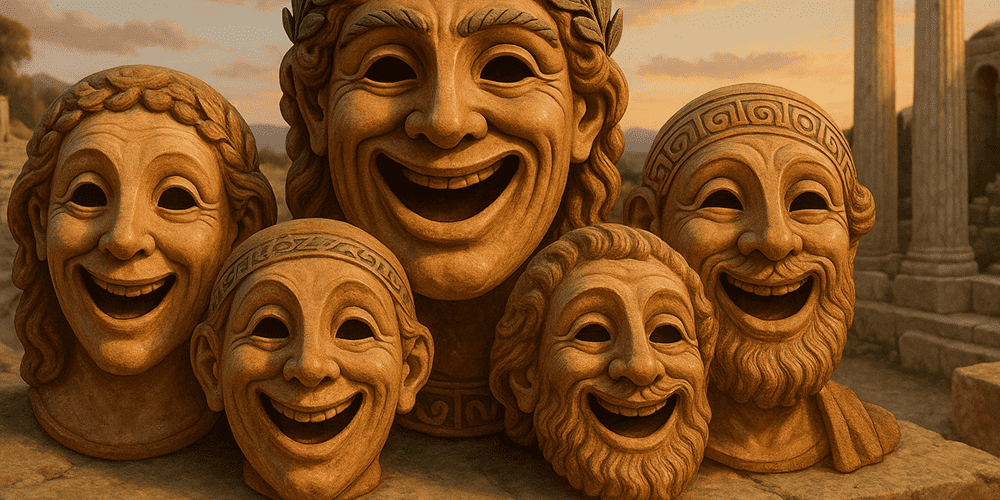Comedy Masks are iconic artifacts of ancient Greek culture, representing the joyful, satirical, and often subversive side of classical theatre. Instantly recognizable by their exaggerated smiles, wide eyes, and expressive features, these masks allowed actors to embody a range of comic characters — from clever slaves and bumbling old men to mischievous youths and boastful heroes. Typically crafted from lightweight materials, Comedy Masks were designed to project emotions to vast audiences in open-air amphitheaters. Originating in the heart of ancient Greece, particularly Athens, Comedy Masks first appeared during the 5th century BCE and have since become enduring symbols of Western performance art.
Historical Origins
The origins of Comedy Masks are deeply intertwined with the birth of Greek theatre itself. The term “comedy” derives from the Greek word “kōmōidía,” meaning “revel song” or “festival song,” reflecting its roots in Dionysian festivals. The earliest comic performances were part of religious rituals honoring Dionysus, the god of wine, fertility, and revelry. Over time, these rituals evolved into structured theatrical competitions, most famously the City Dionysia of Athens.
Early Comedy Masks were simple and utilitarian, but as Greek theatre developed, their design became more sophisticated. By the Classical period, masks were carefully crafted to exaggerate facial features, ensuring visibility and emotional clarity even from the back rows of large amphitheaters. Artifacts such as terracotta mask fragments, vase paintings, and carved reliefs from the 5th and 4th centuries BCE provide invaluable insight into their appearance and use. The evolution of Comedy Masks paralleled that of their tragic counterparts, but with an emphasis on humor, caricature, and social satire.
Cultural Significance and Symbolism
Comedy Masks occupied a vital place in Greek society, functioning as both artistic tools and cultural symbols. In a society where personal identity was often masked by social roles and expectations, the Comedy Mask allowed actors — and, by extension, audiences — to explore taboo topics, lampoon authority figures, and challenge social norms. Wearing a Comedy Mask during a performance was not merely about disguise but about transformation; the mask enabled the actor to become a character, transcending individuality to serve the communal experience of theatre.
Religiously, the masks were linked to Dionysian worship and the belief in theatre as a sacred space for catharsis and collective joy. Myths and legends, such as those surrounding Aristophanes—the master of ancient Greek comedy — are filled with references to the power of laughter and parody. Socially, Comedy Masks made theatre accessible and inclusive, giving voice to the lower classes and poking fun at the elite. Comic and tragic Theatrical Masks have remained enduring symbols of performance and dramatic expression across cultures.
Materials and Craftsmanship
The creation of Comedy Masks was a skilled craft, combining artistry with practical considerations. Traditional materials included linen, wood, leather, and, most commonly, lightweight clay or papier-mâché. The mask-making process began with molding the basic shape over a wooden form, then layering materials to build up facial features. Artisans used knives, chisels, and sculpting tools to exaggerate eyes, mouths, and brows, ensuring each mask conveyed a distinct comic persona.

Masks were painted with natural pigments — reds, whites, blacks, and ochres — to accentuate expressions. Decorative elements, such as attached hair, mustaches, or hats, further defined character type. Regional workshops, especially in Athens and southern Italy, developed their own styles, with some masks exhibiting more refined or flamboyant features than others. Color symbolism was also important: bright hues suggested youth or foolishness, while darker tones often indicated older or more serious characters.
Functions and Usage
Comedy Masks served a variety of functions in both ritual and performance contexts. Originally used in Dionysian processions and ceremonies, masks soon became essential to the structure of Greek comedy. Every actor wore a mask, regardless of age or gender, allowing as few as three performers to play dozens of roles in a single play.
Theatrically, masks enabled quick character changes, unified the chorus, and projected emotions to amphitheater audiences of thousands. Comedy Masks were especially prized for their ability to exaggerate laughter, surprise, and ridicule. They were also used in public festivals, competitions, and, later, Roman adaptations of Greek theatre.
Over centuries, the use of Comedy Masks shifted — while their ritual function waned, their influence persisted in medieval mimes, Renaissance commedia dell’arte, and even modern parody and satire. Today, they are used in educational performances, museum exhibits, and as popular souvenirs symbolizing the enduring legacy of Greek theatre.
Regional Variations
While Comedy Masks are most closely associated with Athens, regional variations existed throughout the ancient Greek world. Southern Italy, for instance, produced distinctive comic masks for use in the “phlyax” plays, which emphasized farce and physical humor. Local workshops developed unique styles, sometimes incorporating elements from neighboring cultures such as the Etruscans or ancient Egyptians.
Comparisons with other theatrical mask traditions — such as Roman, Japanese Noh, or Italian Commedia dell’Arte — highlight both universal and unique aspects of Greek Comedy Masks. Their exaggerated expressions and focus on satire set them apart from the often somber or mystical masks of other societies.
Notable Examples and Collections
Famous examples of Comedy Masks are preserved in some of the world’s leading museums:
- The National Archaeological Museum (Athens): Home to terracotta and marble mask relics from Greek antiquity.
- The British Museum (London): Features Greek vase paintings depicting mask use in comedy and satyr plays.
- The Louvre (Paris) and The Getty Villa (California): Host collections of ancient masks and theatrical artifacts.
- Private collections and academic institutions, as well as online platforms like toddmasks.com, provide further access to rare and reconstructed Comedy Masks.
Archaeological sites such as the Theatre of Dionysus in Athens have yielded mask fragments and stage paraphernalia, offering crucial insights into the world of ancient performance.
Influence on Art and Culture
The legacy of Greek Comedy Masks is profound. Their forms have inspired countless artists, sculptors, and playwrights across centuries. In literature, the works of Aristophanes and Menander remain foundational texts for comic storytelling. Comedy Masks appear in visual arts, from ancient vase paintings to contemporary graphic design and film.

Their influence extends to music, dance, and even fashion — where mask motifs symbolize wit, playfulness, and subversion. The preservation and celebration of Comedy Masks have played a key role in sustaining Greek heritage and influencing theatrical traditions globally, from Shakespearean clowning to modern stand-up comedy.
Contemporary Status and Preservation
Today, the tradition of Comedy Mask-making and performance is kept alive by artists, theatre companies, and educators. Museums and cultural institutions offer workshops, reconstructions, and exhibitions. In Greece, festivals such as the Epidaurus Festival stage classical plays with replica masks, blending ancient techniques with modern sensibilities.
Contemporary mask-makers experiment with materials, digital technology, and new interpretations, ensuring that the Comedy Mask remains a living part of cultural education. Educational programs and masterclasses, both locally and internationally, foster appreciation and skill sharing. Websites like toddmasks.com help document and promote the ongoing evolution of this ancient tradition.
Collecting and Acquisition
The market for Comedy Masks ranges from museum-quality replicas to artist-made souvenirs. Authentic ancient masks are rare and held in institutional collections, but high-quality replicas and contemporary interpretations can be acquired from galleries, theatre shops, and online platforms. Prices vary from affordable decorative pieces to valuable artist commissions.
Collectors should look for provenance, craftsmanship, and authenticity. Supporting ethical practices — such as respecting cultural property laws and supporting living artisans — ensures the sustainability of mask-making traditions.
